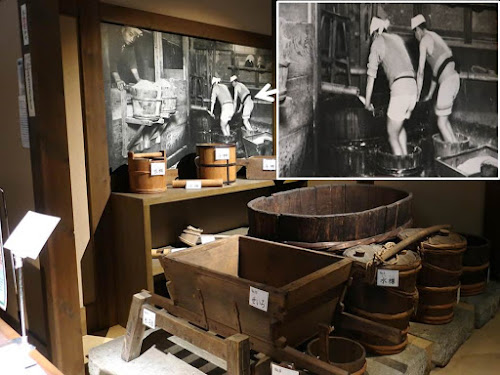the big earthquake destroyed it in 1995. It was
rebuilt and is used as a sake brewing museum again. I felt the heart of sake workers here. Even though their
job was done in the cold winter season, I believe they were still happy, because their products sake made people happy. I like this dry sake and my deceased grandpa
also liked this brand. By the way, the name of another sake beverage district is Fushimi in Kyoto, which is famous for Inari Shrine.
日本酒の二大生産地の一つ、神戸市の灘にある業界7位の酒造会社(2016年)の博物館である。元々は創業時(1659年)の酒蔵だったが阪神・淡路大震災(1995年)で全壊し建て替えられた。酒造りの道具の実物が展示してあり、蔵人の息吹を感じられる。酒のある場は常に楽しいが、冬に行われた手作業の酒造りは大変な苦労だ。でも、造る喜びがあったと思う。なお、もう一方の日本酒の生産地は京都市の伏見である。ちなみに辛口の菊正宗は私の、というか、祖父も含めて我家の常用酒。
Inside the gate, there are a well
and a pumping machine. The ground water in this area is good for making sake
because it contains rich mineral but less iron which changes sake color to
yellow.
門を入ると右側には、井戸と水を汲み上げるはね釣瓶がある。宮水と呼ばれるミネラルが多く鉄分が少ない六甲山の伏流水がある灘は、お酒の産地となった。
There are a big signboard of “Kiku-masamune”,
sake containers and Japanese cider leaf balls which are signs of sake shops in the
entrance hall.
玄関に入ると菊正宗の大看板と酒屋の目印である杉玉、酒を売る時の三升つぼ、五升つぼが並べてある。
The panel which shows 26 sake brewers in Nada
district including the biggest brewer “Hakutsuru”. It is written “Nada is the number
one sake district”.
灘では最大手の白鶴をはじめ、26の会社が酒を作っている。
The special grained rice called “Sakamai” for
sake is exhibited. The center of Sakamai is white, so it is soft. The
microorganisms eat it easily, but it is too soft for human to eat as food.
酒米の展示。米の中心の白い部分(心白)が多くて微生物が食べやすいが、人が食べてもぐしゃっとして美味しくないという。
 |
| Exhibition room of brewing、酒造展示室 |
Wooden equipment
which were used before mechanization are exhibited. 機械化前の酒造りの道具が展示されている。
 |
| Washing rice area “Araiba” |
Washing
rice by bare feet was a really hard job. 素足で踏んで洗う辛い作業だ。
 |
| Steaming area “Kamaba”、釜場 |
Water
was boiled in the big pot and rice was steamed. Steamed rice is easy to eat for
microorganisms. Workers carried it by a pail. 大釜の水を沸騰させて作った蒸気で蒸した米を掻き出して桶に入れて運ぶ。
 |
| Koji fermentation room “Koji-muro”、麹室 |
Koji is
a kind of mold which transforms the starch of rice to glucose. Alcohol yeast
eats glucose easily and makes alcohol. Workers sprinkle spores of Koji-mold on
cooled rice. 冷ました蒸米に麹菌をかけ、麹を育てる。麹は、米のでんぷんを酵母が食べられるブドウ糖に変える。
 |
| Pre-fermentation area ”Motoba”、酛場 |
Lactic
acid bacteria grow at first, then lactic acid kills unnecessary germs,
afterward alcohol yeast grow. The purpose of this process is to grow a lot of Sake-yeast.
Workers stirred tubs properly. まず、乳酸菌を増やしてPHを下げ雑菌を殺した後、アルコールを作る酵母を育て酒母を作る。
 |
| Main fermentation area “Tsukuri-gura”、造蔵 |
Steamed
rice was fed to main fermentation tanks where Koji-mold and Sake-yeast were in.
It took 20 to 30 days to make fruity sake. 蒸米を三度に分けて投入し酵母で発酵する。20日から30日をかける。
 |
| Pressurization and filtration area “Funaba”、 槽場 |
Fermented
sake-broth “Moromi” was filtrated here. Moromi was put in cloth bags at first, then bags
were put in a vessel called “Fune”. Thereafter it was pressed by the press
machine. The cloud sake was made and was purified by precipitation. It was pasteurized in
order to kill microorganisms and inactivate enzymes which made sake too sweet.
発酵を終えた醪(もろみ)を入れた酒袋を、酒槽に入れて、男柱やはね棒と呼ばれる棒を使ってテコの原理で酒を絞り出す。白濁した新酒は、沈殿して滓(おり)引きし、生酒となる。更に、火入れ(熱殺菌と酵素の失活)する。
 |
| Storing area “Kakoiba”、囲場 |
Fresh
sake was aged in tanks from half year to one year. After this process, sake was
packed and shipped. 囲桶で半年から一年熟成させ、その後、瓶詰し出荷する。
 |
| Kaisho-ba in early of the 20th century、昭和初期の会所場 |
“Kaisho-ba” was a staff canteen and a resting
room. By the way, workers came from rural areas; most of them were farmers and they worked here
only in winter which is an off-season for agriculture. While sake
was brewed only in winter which was a good season for it because the low
temperature controls the growth of unnecessary germs.
丹波から来た蔵人たちが酒を造る。会所場は食事をとったり休憩したり「心休まる場である」と書かれていた。2時半に起床で夕方6時まで働いたそうだ。働くのは大変だが、酒が出来上がって皆に喜んでもらえるのだから、造る楽しみがあったと思うし、それが誇りであったと思う。
 |
| Brewery in 1910、1910年の蔵 |
These
are awarded products. The packed sake on the lower shelf is inexpensive and
fresh. I drink it often. 受賞した製品。安くてフレッシュな箱の酒ギンパックは良く飲んでいる。
 |
| Nostalgic posters in the old time、昔のポスター。いい感じ。 |
Making
sake barrels; Japanese cedar is good material to add flesh aroma to sake. This
brewer makes barrels in their factory; the site tour is held several times a
day.
菊正宗は、酒樽を自社生産している。吉野杉の程よい香りが付く。製造見学が一日数回行われている。
Outside
of the museum, you can take a picture of a sake barrel opening ceremony with
wearing Japanese traditional working coats called “Happi”. 記念館の外には鏡割りをできるコーナーがあり、はっぴも借りられる。
I bought
a nice miniature barrel with an opening hummer and a wooden cup. When I hit the
lid of the barrel, it made this high and clear sound.
購入した鏡開きセット。パッケージが楽しいし、木づちでたたくとふたが高く良い音で響く。
The
small theater was filled with Korean tourists. 映像展示室は韓国からのツアーの方で満席。
You can
taste sake with free in a museum shop; I prefer this new brand “Hyaku Moku”(http://hyakumoku.jp/index_en.html). ミュージアムショップでは利き酒ができます。「百黙」というブランド。美味かった。でも、楽しいのは買ってきた鏡開きセット。
The
sakura blossomed when I visited. There is a water wheel cabin behind the tree. 訪れた時には早咲きの桜が咲いていた。木の後ろは水車小屋。
Rice was
polished in the cabin. 水車小屋では、米の精米を行う。
The water for the wheel was introduced from
Sumiyoshi River nearby. It is in Kobe City, but it is pure enough for ducks to drink and eat small creatures. 水車の水は横に流れる住吉川の水を使う。神戸市内だが鴨が餌を求めるほどきれいだ。
New sake is shipped in February and March, so many events are held in this district. You might drink sake with free and can buy new one.
Tourist
information about Kobe: (English)
2月と3月を中心に新酒を味わう蔵開きなど日本酒イベントが沢山ある。
神戸観光局サイト: (日本語)
Reference:
2 funs(楽fun)were found. Visited in March, 2019
,accessed in August, 2020
Previous post: Sake museum in Kyoto
Next post: Museum in the eastern Japan, a big temple is there

















Comments
Post a Comment